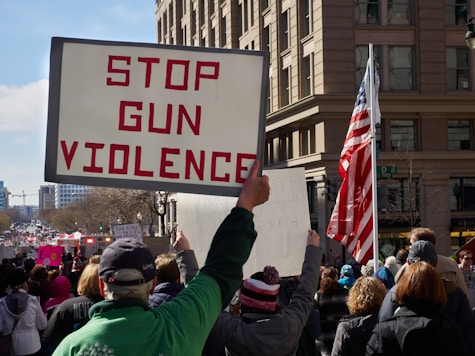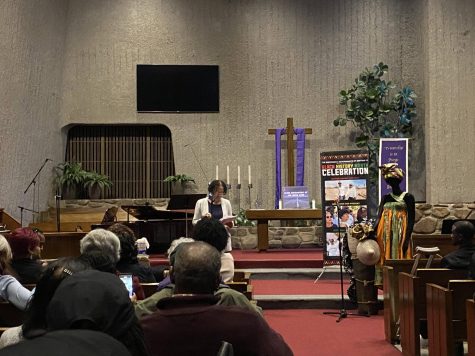Opinion: Stay safe while voting Tuesday
Photo courtesy of Getty Images. Polls across the country will look somewhat like this enforcing social distancing guidelines for voter safety.
Election day is around the corner. President Trump and Joe Biden have had time to share their vision for America to voters and express their concerns for the country, establish what they want to accomplish when elected and try to persuade voters in the middle to vote for them.
Recently, voters have been witnesses or victims to disturbing scenes, especially those who are voting democratically. It has been reported that in some parts of the United States that mailboxes containing ballots or ballot boxes, in general, are being set on fire, and people are being intimidated or threatened to vote for a certain candidate.
A big example is the fake ‘Proud Boys’ voter-intimidation emails from Iran being sent to democratic voters to vote for President Trump to be re-elected into office for another term.
Voter intimidation is against federal law and can lead to fines, imprisonment or both. Voter intimidation is what it sounds like: The use of intimidation to force a voter into voting for a specific candidate or law. Though it was rare to see voter intimidation in the past, in today’s world, it seems to be a hot topic in the media as many people are reporting seeing or being victims of voter intimidation.
It is bad enough for voters to be cautious when going outside because of COVID-19, but now having to deal with voter intimidation from those who believe in using scare tactics to have their candidate win only adds to the many problems voters have to deal with.
People should feel safe when they are voting as they are voting for what they believe is the right choice to further better the United States. No one should feel endangered or insecure about their choices because some outside force feels the need to force people to do things by their agenda.
You can still vote without feeling a set of eyes over your shoulder, waiting to discourage you from doing so. Mail-in is the safest way to vote since you can fill out the ballots from the safety of your own home or in another private area. Despite COVID-19 forcing us to maintain social distancing everywhere, voters can still go outside and vote.
If you are part of the group of the people who wish to vote at voting polls, make sure to be extra prepared. Aside from the usual aspects of social distancing like wearing masks, washing hands,and maintaining six feet apart from one another, there are other ways to keep yourself safe.
Voting during odd times is a great way to vote to avoid lines. An example will be voting when the polls are barely opening or closing or when everyone is out working. This isn’t the most guaranteed as many voters could have the same mindset about voting at odd hours, but it is still effective.
In the past, parents would bring their kids to voting polls for whatever reasons that may be. In today’s world, however, that may not be the best idea. If you are going to vote at the polls, schedule a time and talk with relatives or friends who could babysit your children for a time while you and your partner go out to vote.
Keeping children away from voting polls not only lessens the risks of them getting infected with COVID-19, but it reduces the chances of anyone in your family getting it, too, as bring too many people to a poll only increases the probability of accidentally contracting COVID-19.
Keep your guard on at all times, and know the environment around you. You never know when someone is not following the rules and puts everyone else at risk. Some people don’t care about others’ safety, and that is a terrible thing. If you do happen to be near a person who doesn’t care, avoid them to keep yourself as secure as possible.
Lastly, report any signs of voter intimidation. As previously stated, a news topic that is being brought up a little more frequent than usual is voter intimidation, and it seems only to increase as the days go by and election day gets closer. Voter intimidation sometimes isn’t easy to spot, but here are some examples of what could be used to identify voter intimidation:
- Violent behavior inside or outside a polling site
- Verbal or physical threats of violence
- Confronting voters while wearing military-style or official-looking uniforms
- Brandishing firearms
- Spreading false information about voter fraud or voting requirements
- Disrupting voting lines or blocking the entrance to a polling place
- Following voters to, from, or within the polling place
- Aggressively questioning voters about their qualifications to vote
If you witness or fall victim to any of these above, or in general feel like someone is intimidating you or someone else to vote for their candidate, document what happened in real-time with photos or videos, collect witness information and notify any on-site official.
Voting has never been more urgent than it is today. The numbers showing how dramatically voter turnout is spiking only proves that this election is one of the most important in the United States’ history. As essential as voting is, it is equally important to maintain safety during voting too.
If you still haven’t voted, please do. Election day is on Nov. 3. Every vote matters, including yours, whether you believe it or not.

Omar Romero is the online editor, staff reporter for The Chaparral. His career goal is to become either a sports radio host, sports commentator on television...















